What’s up with the very hungry caterpillars?
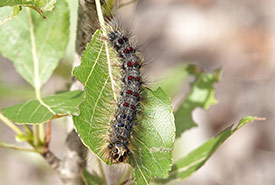
Each LDD caterpillar can eat one square metre of leaves in one season (Photo by Paul Prior, CC BY 4.0)
If you have young children in your life, The Very Hungry Caterpillar by the late and celebrated children’s author Eric Carle, is probably a familiar read and has been a fan favourite since 1969. This spring and summer though, there is another hungry caterpillar that has become a household name in parts of Canada — Lymantria dispar dispar (LDD), formerly called European gypsy moth, an invasive species in Canada. (Read this blog on how they arrived in North America.)
What does the LDD caterpillar look like? Why are they problematic?
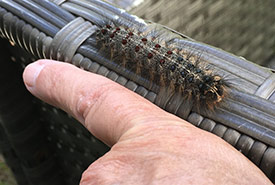
LDD moth caterpillar (Photo by macnomadic, CC BY-NC 4.0)
When mature, LDD caterpillars are approximately 50 millimetres long, hairy, dark-coloured, with a row of five pairs of blue dots followed by a double row of six pairs of red dots on their back. They feed on the leaves of over 400 plants and especially love deciduous trees, like sugar maples, oaks, elm and birch, but will feed on coniferous trees if their preferred leaves run out.
One caterpillar can eat one square metre of leaves in one season.
While hardwood trees may survive up to three years of severe defoliation, coniferous trees may not survive one bad infestation.
LDD infestations are cyclical
This species goes through a population boom and crash cycle every 10 to 12 years. A Viral disease as well as a fungal disease usually cause the population to crash after years of heavy outbreak. Eric Cleland, the Nature Conservancy of Canada’s (NCC’s) director of invasive species programs in the Ontario Region, says that even armed with the best knowledge from egg mass surveys and the assessment of larval mortality, it is still a bit of a crystal ball with predicting the outlook for 2022. He says that most of Ontario is nearing the end of a boom cycle and a crash is expected, hopefully for 2022.
Are there natural predators that eat LDD moth caterpillars?
Parasitic wasps, some mammals, birds and other insects feed on LDD caterpillars and egg masses.
Just what does an infestation look like?
Back in early May, I started seeing one very thin, black and hairy caterpillar on my kids’ outdoor slide. To be honest, I thought it was a streak of bird poop from afar. Then, I started seeing Facebook posts in the native plants gardening group where members reported the invasion of dark caterpillars, lots of them, and their voracious appetite was disconcerting. My first encounter was probably of the moth’s third instar (a developmental stage between each molt of arthropods) when the caterpillar is about seven millimetres. Now, I am seeing posts about their devastation on oaks and maples, with trees bare to the branches and the grounds littered with chewed up leaf confetti.
It also makes hiking through infested areas with lots of deciduous trees full of angst, as, on a recent hike, I had to duck every which way to avoid the dangling caterpillars, yet still managed to have some land on my clothes.
My friend texted me photos of her neighbour’s tree, and the images made my skin crawl.
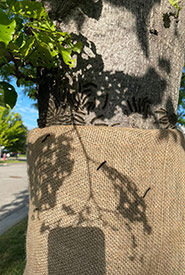
A tree infested by LDD caterpillars in a suburban yard (Photo by Kyle)
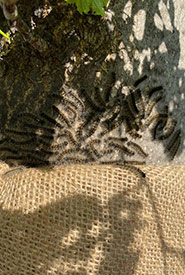
Closer up photo of caterpillars above the burlap trap (Photo by Jen)
What should you do if you are experiencing an LDD moth infestation?
First of all, do not handle the caterpillars with bare hands. Some people develop an itchy rash from touching the caterpillars’ tiny hairs, which contain histamine. These caterpillars can catch you by surprise when they fall from trees or if you stand under a tree canopy with caterpillars dangling from their silks, waiting to be carried by the wind to their next host plant.
Here are some things that homeowners can do to manage infested trees and plants:
Wrap your tree with a burlap band (May to August)
1. Put a piece of burlap around the tree trunk at chest height. Tie a piece of rope or twine in the middle. Pull the section above the string down until it meets the base of the burlap.
2. Check your burlap band in the afternoon, when caterpillars are likely to seek shelter from the mid-day sun inside the burlap.
3. Prepare a bucket of soapy water.
4. Scrape caterpillars into the bucket and let sit for a day or two, then dispose of the caterpillars. Wear gloves to avoid direct contact with the caterpillars.
5. Continue to check your trap throughout the day and season.
What not to do:
Do not use adhesive tape around the tree to trap caterpillars, as this can be a death trap for birds and other insects.
Do not handle caterpillars with bare hands.
Scrape egg masses from trees (August to early May)
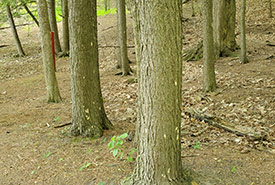
Trees with LDD moth egg masses (Photo by Wendy Ho/NCC)
1. Use a scraper tool (e.g. a butter knife or credit card) to scrape off egg masses into a bucket of soapy water.
2. Let sit for a day or two and dispose in the garbage.
Learn to identify LDD caterpillars from their lookalikes
It is important to accurately identify LDD caterpillars from other native lookalike species. According to Eric, these include eastern tent caterpillar (mostly destructive to ornamental trees), forest tent caterpillar (which can also cause widespread defoliation in forests) and fall webworm (a late-summer defoliator in Ontario’s deep south). Check your provincial website for information, such as this page from the Province of Ontario with a visual guide for comparison. You can also submit your observation to iNaturalist for identification.
Report invasive species
Use EDDMapS (available on mobile app and desktop site) or iNaturalist to report sightings to help document invasive species distribution in the country.
The caterpillars have turned into moths. Now what?
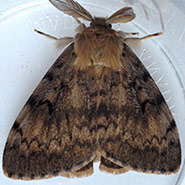
Male LDD moth (Photo by robertdifruscia, CC BY-NC 4.0)
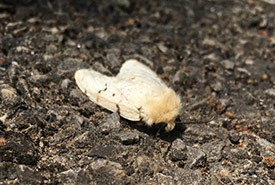
A female LDD moth on the ground (Photo by thatrobiam, CC BY-NC 4.0)
Male LDD moths are mainly brown and females are mainly white. Female moths are flightless and lay eggs on tree bark, branches or other sheltered places, like rock piles, piles of logs, lawn furniture, recreational equipment, etc.
The adult moth life stage is short lived. So, control measures are best done in the moth’s larval stage. Scrape off any egg masses you see from August to the following spring.




